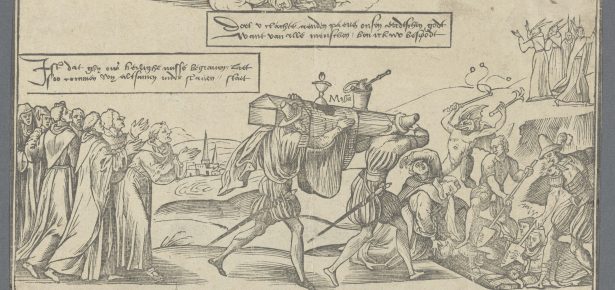
Anyone who travels through the adjacent countries of Belgium and the Netherlands today immediately sees the contrast: Belgium is full of resplendent, lavishly decorated Catholic churches, while its neighbor to the immediate north is home to sober, whitewashed Protestant houses of worship. Two very divergent religious cultures are at work here. The two countries’ close proximity makes the contrast all the more glaring. The difference becomes even more interesting when one considers that these two nations (along with Luxemburg) were once, hundreds of years ago, parts the same larger composite state, the seventeen Habsburg Netherlands. So why now, in the present day, do the Netherlands seem so Protestant and Belgium so Catholic?
The answer lies in the sixteenth century, when the Habsburg Low Countries (a distant ancestor to today’s Benelux) found itself in the grip of the Reformation. Starting in the 1520s the Protestant rebellion against the medieval Catholic Church afflicted Europe, and the Low Countries was no exception. Indeed, the region’s commercial networks made the ideas of reformers like Luther and Calvin easily accessible to its fairly literate population. The Netherlandish Reformation began in the south, in territories such as Flanders and Brabant, core regions of present-day Belgium. A significant (and militant) minority of the Netherlandish population harbored Protestant beliefs despite the very fierce persecution meted out by the Habsburg government, which was committed to defending Catholicism. Over the course of forty years Netherlandish Anabaptists and Reformed Protestants faced a relentless government effort to quash their heretical beliefs. To no avail: this Habsburg “inquisition” proved so unpopular, even among Catholics, that it ignited a revolt against Habsburg power by Netherlanders in the 1560s. The Revolt of the Netherlands was by turns a rebellion, a religious war, a civil war and a conflict among great powers. After about twenty-five years of fighting, seven northern provinces of the original Low Countries gained independence from the Habsburgs, while the remaining ten provinces in the south remined under the dynasty’s control. The Revolt of the Netherlands had effectively created two states, the Dutch Republic in the north and the archducal Netherlands in the south. These were the ancestral states of the modern-day Netherlands and Belgium.
In the northern Dutch Republic, where the rebels gained power, the reward to Reformed Protestants (popularly known as Calvinists) for their support of the rebellion was complete control of nearly all churches and religious spaces. The Reformed Church became the official church of the Republic, and while other confessions were allowed freedom of conscience but not freedom of worship. The result was a state that was, religiously speaking, Protestant and pluralist at the same time. Meanwhile, in the south, the restored Habsburg government insisted on a uniformly Catholic population, and about 100,000 Protestants emigrated out of the country, most of them to the Dutch Republic. In this way Netherlandish Protestantism shifted its center from south to north, while Netherlandish Catholicism flourished in the south down to the twentieth century.
Reformation in the Low Countries tells this story. I was prompted to write it after repeated inquiries from colleagues in early modern history for recommendations for a general history of the Netherlandish Reformation. This is the first ever narrative synthesis in English of religious change for the whole of the sixteenth-century Low Countries, not just north or south. It describes reformation as a process of religious transformation for Netherlanders of all confessions, Protestant and Catholic.
Latest Comments
Have your say!